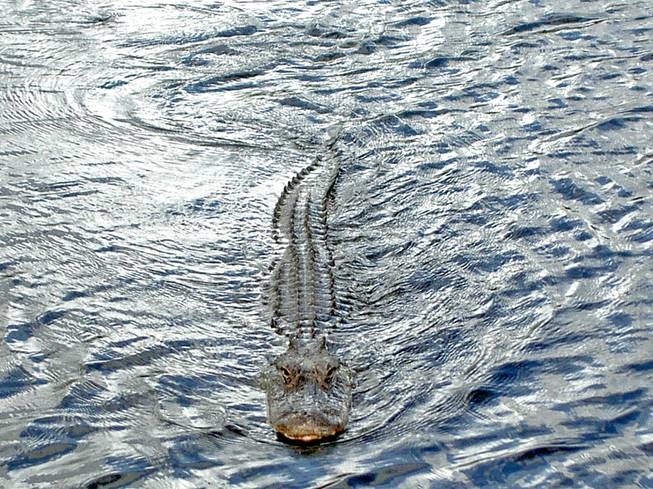
Stephanie Tavares
Too close for comfort: An alligator approaches shore at Paradise Key Hammock in the Everglades National Park. The area was the first part of the Everglades to be preserved, with 120 acres dedicated as a state park on Nov. 22, 1916. The area was later donated to the National Park Service to be incorporated into the boundaries of the Everglades National Park.
Friday, June 12, 2009 | 3 a.m.
Nearly everything you have heard about the Florida Everglades is right.
I came to that realization while standing ankle deep in a mosquito-infested watery meadow in a lightning storm with a 6-foot-3 radio reporter (carrying a 2 foot microphone, no less).
And I thought: “This place is trying to kill me.”
I was right. It was trying to kill me.
It didn’t want me there. Mother Nature was saying, “Just leave me be, thank you very much, and go back to your air-conditioned condo on the coast.” (Sound familiar?)
It’s not a unique revelation.
Spanish explorers were probably the first Westerners to discover the Everglades’ thirst for human blood.
They stopped by the Everglades while raping and pillaging their way across the Americas in the 16th century.
The few survivors were less than enthusiastic. The firsthand accounts of their experiences, which I read in college, conjured up images of vast impenetrable, smelly, mosquito- and alligator-infested swamps.
Since then, Florida has only expanded its killing repertoire: The Everglades are now home to freewheeling, fast breeding Burmese pythons capable of eating everything from lap dogs to adult alligators. Hired thugs have been known to dispose of inconvenient politicians among the cypress trees. And its coastal waters regularly play host to drug smugglers with automatic weapons.
So let’s just say it was not a place I ever wanted to find myself — especially in early June at the beginning of the hurricane season.
But earlier this month that is exactly where I was as part of a fellowship with the Scripps Howard Institute on the Environment.
Mother Nature made her presence known from Minute One as Florida’s insect population began a weeklong all-you-can-eat Tavares buffet in the parking lot of the Fort Lauderdale airport.
In one week, with only a few hours of outdoor exposure, I was charged by an alligator, sneaked up on by a black-tipped shark, chased onto the beach by a gigantic stingray and stung by jellyfish.
And you know what? It was totally worth it.
Because I also watched a threatened loggerhead turtle knead and sculpt the sand over her newly laid eggs while crying in pain and exhaustion on Singer Island.
In Key Largo I swam over a brain coral the size of my recliner. The coral grows only 2 centimeters a year.
An osprey, a threatened species, flew over my head while I was canoeing on the Loxahatchee River.
And I met dozens of people from water managers to marine biologists to farm advocates working to save the wild areas and cities of Florida by attempting to correct a hundred years of disastrous water and land management policies.
Twenty-five environmental journalists from various media were brought from across the country to Florida Atlantic University’s honors college June 1 through 6 in Jupiter, Fla., to learn about what went wrong in south Florida, how poor water and land management can hurt animals and people and what they hope they can do to correct it.
The goals were to give national media a better understanding of Florida and to give reporters a chance to relate what happened there to environmental trends in their home states.
You wouldn’t think a business reporter from Las Vegas would have much luck with that.
But the connections were striking.
Central to the history of both Florida and Nevada are stories of man fighting nature. Just as the Everglades tried to kill Hernando De Soto, the Mojave tried to kill Francisco Garces.
Both states fought to turn what most saw as a wasteland into the sprawling suburbs of our dreams.
And both communities depend on massive water management efforts for their survival.
Where the Army Corps of Engineers drained the Everglades to make dry land for farms and cities, Southern Nevadans have blanketed a desert with lawns, fountains and swimming pools.
Florida’s water and land manipulation resulted in major water quality problems, massive wildlife die-offs and damaged fisheries.
Ours has led to dependence on quantities of water so large that dwindling water supplies threaten the extinction of not just sheep and tortoises, but also a major urban city.
So as we look at ways to maintain our way of life, from a third straw in Lake Mead to pipelines to rural Nevada aquifers, it is not unwise to look at what man’s attempts to control nature wrought in south Florida and tread more carefully.
Otherwise, our children may never see a Columbia spotted frog or a pirate battle on the Strip.


Join the Discussion:
Check this out for a full explanation of our conversion to the LiveFyre commenting system and instructions on how to sign up for an account.
Full comments policy